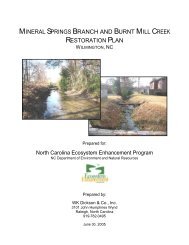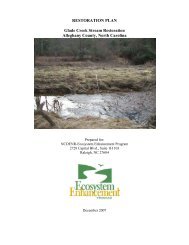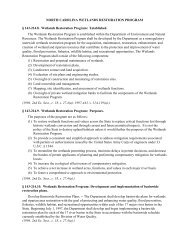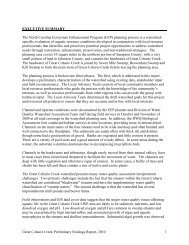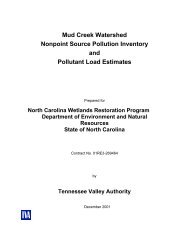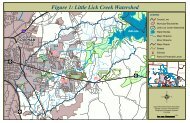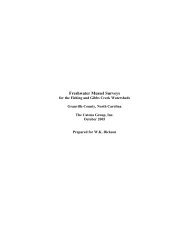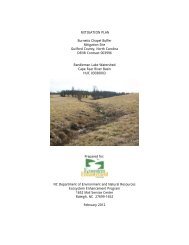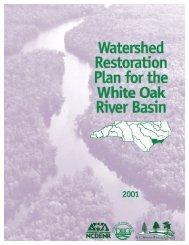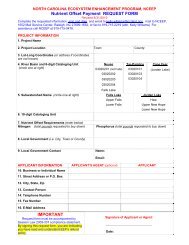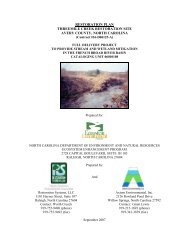Mud Creek Watershed Restoration Plan - Henderson County Center
Mud Creek Watershed Restoration Plan - Henderson County Center
Mud Creek Watershed Restoration Plan - Henderson County Center
You also want an ePaper? Increase the reach of your titles
YUMPU automatically turns print PDFs into web optimized ePapers that Google loves.
Flat Rock Ordinances• Subdivision buffer requirement. This requires protection of a 50 foot set back onperennial streams, lakes, and wetlands as they appear on USGS topographic maps; thesetback is divided into two areas—a 25 foot zone of natural vegetation adjacent to thechannel followed by a 25 foot belt of either managed or natural vegetation. Perennialstreams not on a USGS topo, require a 10 foot buffer of natural vegetation.• Floodplain ordinance. No structures, with some exceptions, or fill are allowed in the 100year floodplain.• Stormwater management. Both subdivisions and other types of commercial andresidential developments are required to construct stormwater drainage facilities toprevent downstream erosion/sedimentation and follow existing natural drainage. Wherefeasible, stormwater discharge points must discharge through vegetated areas. Inaddition, commercial and residential developments (excluding subdivisions) are requiredto have stormwater controls to insure that post-development stormwater runoff rates donot exceed pre-development rates.2.6.2 Land Use <strong>Plan</strong>ning and ZoningLocal governments use zoning and land use planning to guide growth, ensure adequateinfrastructure and services and to protect environmental resources. Local zoning ordinances area good indicator for how an area, like the <strong>Mud</strong> <strong>Creek</strong> watershed, might grow and develop andhow this growth might impact water quality. Table 2.5 summarizes the current zoning in the<strong>Mud</strong> <strong>Creek</strong> watershed. The zoning categories used in Table 2.5 generalize some 63 distinctzoning classifications of the five governmental entities with zoning authority in the <strong>Mud</strong> <strong>Creek</strong>watershed.The “traditional” zoning districts, such as residential, commercial and industrial, account formore than 43% of the total <strong>Mud</strong> <strong>Creek</strong> watershed. Each of these zoning districts containselements regulating lot size, structure size, and property line setbacks. To the extent that landuse affects water quality, each of these districts can have considerable positive and negativeimplications for water quality. Most districts regulate the size of the lot, thus affecting densityand potentially the degree of urban runoff. However, none of the districts regulate the amount ofimpervious surface or require permanent measures to control storm water runoff. Over 78% ofthe watershed falls within the zoning jurisdiction of <strong>Henderson</strong> <strong>County</strong>, with over 54% of thewatershed falling within the <strong>County</strong>’s Open Use Zoning District. Through issuance of a specialuse permit, open use zoning allows for many land uses, such as mining and extraction operationsand junkyards, that could pose a threat to water quality. Given the flexibility inherent in OpenUse Zoning, it is difficult to project the potential impacts to water quality from futuredevelopment in the watershed.Section 2: <strong>Watershed</strong> Characterization Page 20




